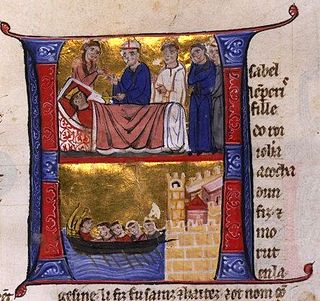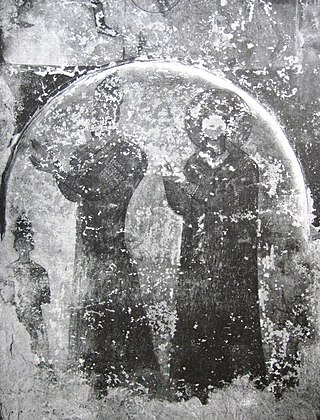
Year 1228 (MCCXXVIII) was a leap year starting on Saturday of the Julian calendar.

The Battle of the Indus was fought on the banks of the Indus River, on 24 November 1221, by two armies commanded by Shah Jalal al-Din Mingburnu of the Khwarazmian Empire, and Genghis Khan of the Mongol Empire. The battle, which resulted in an overwhelming Mongol victory, was the concluding engagement in the Mongol conquest of the Khwarazmian Empire.
The Battle of Parwan was fought between Sultan Jalal ad-Din Mingburnu of the Khwarazmian Empire and the Mongols ruled by Genghis Khan in September 1221 AD at Parwan, north of Kabul, in present-day Afghanistan. Jalal ad-Din had previously attacked a detachment of Mongols near Wilan (Waliyan), which provoked Genghis Khan into sending an army of 30,000 troops under Shigi Qutuqu. As a result of the tactics adopted by Jalal ad-Din, the Mongol army was destroyed in a two-day battle. As news of the Mongol defeat spread, several cities, including Merv and Herat, which had previously surrendered and accepted Mongol rule, rebelled. In response, Genghis Khan moved to battle Jalal ad-Din, who had lost half of his troops to desertion due to a quarrel over the division of spoils after the battle, and was forced to move to Ghazni to prepare to retreat to India. Genghis Khan intercepted Jalal ad-Din's army as he was preparing to cross the Indus River, and in the ensuing battle he lost his army, treasury and family, but survived to eventually establish a power base in Punjab and Sindh.

Rusudan, a member of the Bagrationi dynasty, ruled as queen regnant (mepe) of Georgia in 1223–1245.

The Battle of Basiani was fought between the armies of the Kingdom of Georgia and the Seljukid Sultanate of Rum in the Basiani Valley, 60 km north-east of the city of Erzurum in what is now northeast Turkey. The date of the battle has been debated, but recent scholarship tends to favor the years 1203 or 1204. According to modern Turkish historians, the site of the battle is usually identified as the castle of Micingerd (Mazankert).
The Battle of Garni was fought in 1225 near Garni, in modern day Armenia, then part of the Kingdom of Georgia. The invading Khwarazmian Empire was led by Jalal al-Din Mangburni, its last Sultan, who was driven from his realm by the Mongol Empire and was trying to recapture lost territories. The battle ended with a Khwarezmid victory and is marked as a disastrous event in Georgian history due to betrayal. As a result, the royal court of Georgian Queen Rusudan (1223–1245) moved to Kutaisi and the country was exposed to subsequent looting during the Mongol invasions of Georgia.

The Mongol invasions of Georgia, which at that time consisted of Georgia proper, Armenia, and much of the Caucasus, involved multiple invasions and large-scale raids throughout the 13th century. The Mongol Empire first appeared in the Caucasus in 1220 as generals Subutai and Jebe pursued Muhammad II of Khwarezm during the destruction of the Khwarezmian Empire. After a series of raids in which they defeated the combined Georgian and Armenian armies, Subutai and Jebe continued north to invade Kievan Rus'.

The Kingdom of Georgia, also known as the Georgian Empire, was a medieval Eurasian monarchy that was founded in c. 1008 AD. It reached its Golden Age of political and economic strength during the reign of King David IV and King Tamar the Great from the 11th to 13th centuries. Georgia became one of the pre-eminent nations of the Christian East, and its pan-Caucasian empire and network of tributaries stretched from Eastern Europe to Anatolia and northern frontiers of Iran, while Georgia also maintained religious possessions abroad, such as the Monastery of the Cross in Jerusalem and the Monastery of Iviron in Greece. It is the principal historical precursor of present-day Georgia.

Tsotne Dadiani was a Georgian nobleman of the House of Dadiani and one of the leading political figures in the time of Mongol ascendancy in Georgia. Around 1246, he was part of a failed plot aimed at overthrowing the Mongol hegemony, but survived arrest and torture in captivity that befell upon his fellow conspirators when their designs to stage a rebellion was betrayed to the Mongols. A story from the medieval Georgian annals relating Tsotne's insistence on sharing his accomplices' fate that moved the Mongols to mercy made him a popular historical figure and a saint of the Georgian Orthodox Church.

The 1244 siege of Jerusalem took place after the Sixth Crusade, when a Khwarazmian army conquered the city on July 15, 1244.
Between 1219 and 1221, the Mongol forces under Genghis Khan invaded the lands of the Khwarazmian Empire in Central Asia. The campaign, which followed the annexation of the Qara Khitai Khanate, saw widespread devastation and atrocities. The invasion marked the completion of the Mongol conquest of Central Asia, and began the Mongol conquest of Persia.

Jalal al-Din Mangburni, also known as Jalal al-Din Khwarazmshah, was the last Khwarazmshah of the Anushteginid dynasty. The eldest son and successor of Ala ad-Din Muhammad II of the Khwarazmian Empire, Jalal al-Din was brought up at Gurganj, the wealthy capital of the Khwarazmid homeland. An able general, he served as second-in-command to his father in at least one battle; however, since he was the son of a concubine, he was challenged as successor by a younger brother, whose cause was supported by the powerful Queen Mother, Terken Khatun. Nevertheless, after the Mongol conquest of the Khwarazmian Empire led to his father's flight and death on an island in the Caspian Sea, Jalal-al Din gained the loyalty of the majority of Khwarazmian loyalists.
The Khwarazmian or Khwarezmian Empire was a culturally Persianate, Sunni Muslim empire of Turkic mamluk origin. Khwarazmians ruled large parts of present-day Central Asia, Afghanistan, and Iran from 1077 to 1231; first as vassals of the Seljuk Empire and the Qara Khitai, and from circa 1190 as independent rulers up until the Mongol conquest in 1219–1221.

The Hundred Thousand Martyrs are saints of the Georgian Orthodox Church, who were put to death, according to the 14th-century anonymous Georgian Chronicle of a Hundred Years, for not renouncing Christianity by the Khwarazmian sultan Jalal al-Din upon his capture of the Georgian capital of Tbilisi in 1226. The source claims the number of those killed were 100,000. The Georgian church commemorates them on 13 November.
Ghias ad-din was a member of the Seljuk dynasty of Rum and husband of Queen Rusudan of Georgia from c. 1223 to 1226. A son of the emir of Erzurum Mugith al-Din Tughril Shah, he converted to Christianity on his father's order so as he could marry the queen of Georgia. Ghias ad-din's position at the Georgian court was weak and the spousal relationship was strained due to Rusudan's unfaithfulness. He shifted back and forth across the religious and political divide during the Khwarezmid invasion of Georgia in 1226. Around the same time, he was repudiated by Rusudan, and thereafter disappears from records, leaving two children behind, a daughter, Tamar, and a son, David.

The Georgian–Seljuk wars, also known as Georgian Crusade, is a long series of battles and military clashes that took place from c. 1048 until 1213, between the Kingdom of Georgia and the different Seljuqid states that occupied most of Transcaucasia. The conflict is preceded by deadly raids in the Caucasus by the Turks in the 11th century, known in Georgian historiography as the Great Turkish Invasion.
Avag Zakarian was an Armenian noble of the Zakarid line, and a Court official of the Kingdom of Georgia, as atabeg and amirspasalar of Georgia from 1227 to 1250.

The Khwarazmian army, also called the Khwarazmiyya, maintained itself as a force of freebooters and mercenaries between 1231 and 1246, following the Mongol conquest of the Khwarazmian Empire (1221) and the death of the last Khwarazmshah, Jalal al-Din (1231). It was active in Upper Mesopotamia, Anatolia, Syria and Palestine and shifted its allegiance several times, often acting autonomously before it was defeated and destroyed by the Ayyubids.

Tughril Shah, also Abdu'l Harij Muhammad Mughis ad-din Tughril Shah ibn Kılıç Arslan II (r.1202-1225) was a Turkoman king of the "Seljuqs of Erzurum", following the fall of the Saltukids in the region, one of the Anatolian beyliks. He was another son of Kılıç Arslan II, who in 1186 had partitionned his kingdom in Anatolia between several of his numerous sons. He was succeeded by his son Rukn al-Din Jahanshah bin Tughril.

Ivane I Zakarian was an Armenian prince, and a Court official of the Kingdom of Georgia holding the offices of Msakhurtukhutsesi (Majordomo) and Atabeg for Queen Tamar of Georgia during the early 13th centuries. He was a prince of the Zakarid dynasty, the son of Sargis Zakarian, and the younger brother and successor of Zakare II Zakarian. He was also ruler of feudal lands in the Kingdom of Georgia.














